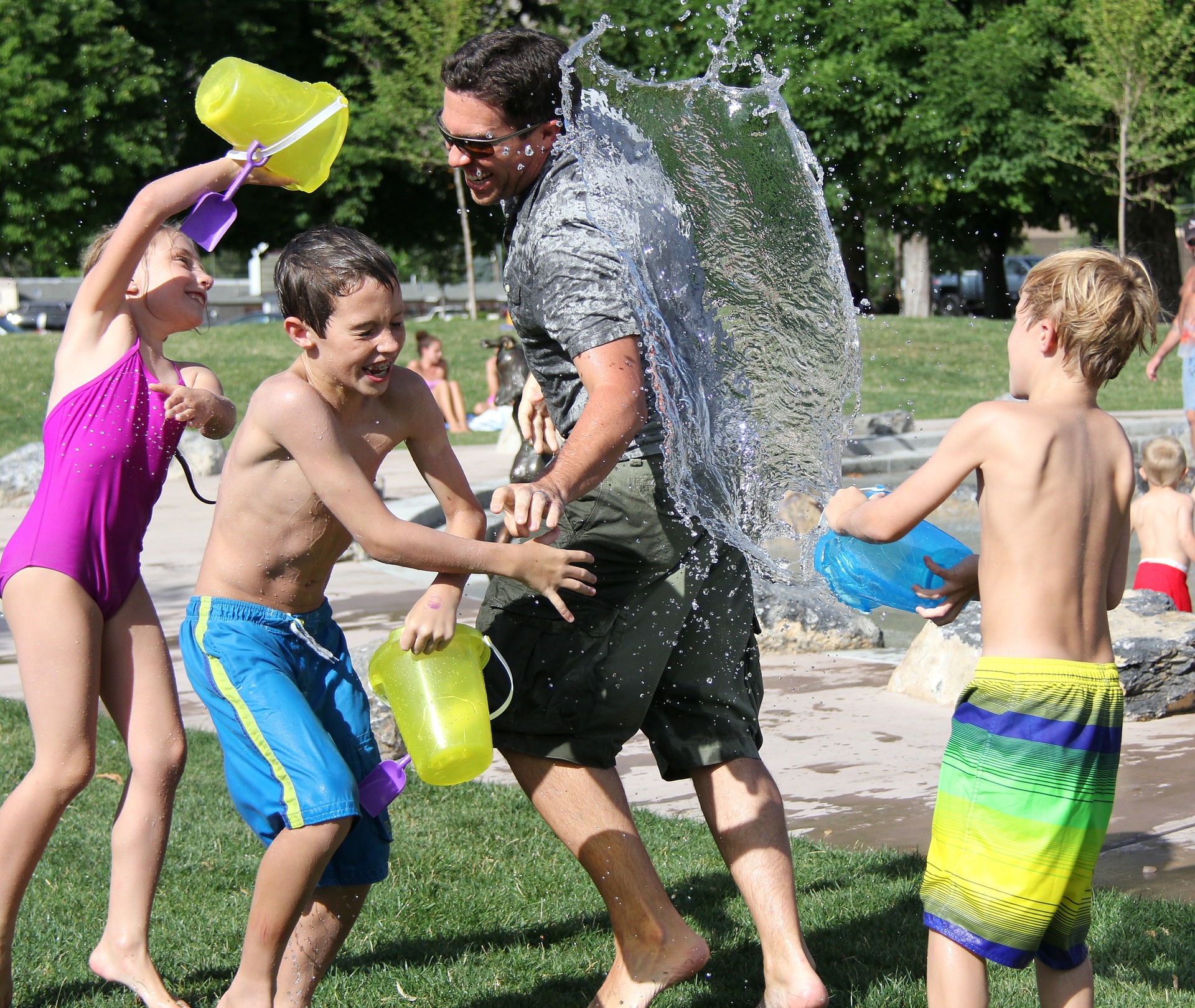There’s still plenty of summer left—be safe!
August 9, 2017
Back-to-school time may be looming, but it’s still warm out with lots of beach and pool visits to be had, as well as time spent on the playground in the heat. We’ve put together a list of summer safety tips to be sure you enjoy the dog days of summer safely. These tips apply to both children and adults; no one can have a good time if they’re sunburned or injured.
1. Lather on the sunscreen
Sunscreen should be applied right after children are up and dressed. Since sunscreen takes at least 15 minutes to get absorbed and start protecting you, if you wait until your children (and you!) are already in the sun, you’re behind the eight ball. Remember to re-apply after swimming and throughout the day, even if it’s cloudy out. UV rays can penetrate through fog and haze. If your child is going to camp, be sure to pack extra sunscreen (spray sunscreen is easier for little hands to use) and show your child how to use it. And be sure to use enough. Most of us don’t; a good rule of thumb is we need about a shot-glass full to protect our whole body. Less is definitely not more here.
2. Drink that water!
The importance of drinking fluids (preferably water) cannot be overstated. During warm weather, and especially when we sweat, our bodies lose fluid rapidly. Children often can’t tell if they need water, and by the time they are thirsty they are likely already a bit dehydrated. Teach them the importance of drinking fluids, and be sure they take adequate breaks during outdoor activities.
3. Watch for heat illness
When our body is exposed to more heat than it can handle, several heat related illnesses may occur. Heat exhaustion and heatstroke are two such illnesses, and both can be very dangerous especially in infants and young children. For heat-related illness, the best defense is prevention:
-Never leave infants, children or pets in a parked car—ever
-Dress infant and children in loose, lightweight, light-colored clothing
-Schedule outdoor activities carefully, for morning and evening hours (avoiding heat of day)
-Stay cool with cool showers or baths
-Seek medical attention immediately if someone you know has symptoms of heat illness
When we lose excessive amounts of salt and water and the result can be heat exhaustion. Symptoms include severe thirst, fatigue, headaches, nausea, vomiting and sometimes, diarrhea. Other symptoms include profuse sweating, clammy/pale skin, dizziness, rapid pulse and slightly elevated temperature. Anyone experiencing heat exhaustion should be moved to a shaded or air-conditioned area, given water or other cool (non-alcoholic) beverages, and apply wet towels or take a cool shower.
Heat exhaustion can turn into heatstroke if not treated. When our body is having difficulty sweating and our temperature rises quickly, you may experience heatstroke. This happens when our body cannot get rid of excess heat. Having very hot skin and being confused are two symptoms. Getting rid of excess body heat is critical. Call for emergency help immediately. The person should be moved into the shade into a half-sitting position. Spray the victim with water and fan them vigorously; if humidity is higher than 75%, apply ice to their neck, armpits or groin.
4. Be safe in the water
According to Injury Facts 2017 (nsc.org), an average of nine people die from drowning in the U.S. every day. Drowning is a concern for young children, and teens and young adults too. Some basic water safety precautions for young children include:
-Never leave your child alone near water; if you must leave, take your child with you
-Find age-appropriate swim lessons for your child (remember that lessons do not make a child “drown-proof”)
-Always keep your eyes on your child; never rely on a lifeguard to watch your child
-Don’t let children play near pool drains and suction fittings; hair, fingers/toes, and swimsuits can get caught and become part of the suction
-Remember that even rivers and lakes have undertows
-Always keep a first aid kit handy
-Get trained in CPR
-If a child is missing, check the water first
5. Know about dry drowning/secondary drowning
Many parents think once their children are finished swimming and away from water they can relax. Not necessarily so. There is a term that should be in every parent’s vocabulary. The following are excerpts from an article from ChildrensMD.org, by Dr. Kathleen Berchelmann explaining the term “dry drowning” and what you need to know:
“There is some debate about the definition of the term “dry drowning.” Usually this term refers to situations where some water got in a child’s lungs and the child has a severe inflammatory reaction to the water hours after the incident. This phenomenon is also called “secondary drowning” or “near drowning.” There is another phenomenon, also sometimes called “dry drowning” in which suffocation occurs but no water ever entered the lungs. In these rare situations the larynx (voice box) spasms and stays shut, causing involuntary suffocation. Sometimes this spasm is triggered by water droplets hitting the larynx, or a sudden high speed submersion under water such as off a high-dive or a high speed water slide. This latter form of dry drowning generally doesn’t occur when kids are simply swimming or playing in the pool.”
Symptoms and warning signs of “dry drowning”:
Coughing: Any person who has persistent coughing after playing in the water is at risk for water in their lungs. Don’t go to bed worrying; take your child in for a medical evaluation.
Water rescue: Any person who was submerged in water and came up struggling, especially if he/she had to be retrieved from the water, needs medical evaluation.
Amnesia: Any person who was unconscious underwater or has limited memory of an incident that occurred in water needs immediate medical care.
Behavior change: If your child feels sick, acts too sleepy, or has a change in mental behavior after a day at the pool, take it seriously. The worst thing that can be done with a child who may have inhaled water is to put them to bed. They need immediate medical care.
Vomiting: Vomiting after a day of swimming can be due to waterborne infectious disease, but can also be a sign of severe illness due to dry drowning. This is a sign stress from the body due inflammation.
While dry drowning is extremely rare, it is important to know the signs and get immediate medical attention if someone is not behaving normally after swimming.
6. Keep mosquitos and ticks away
Outside time is fun time—that is until the bugs start biting, or your find a tick on your child. Some easy precautions can keep you and your children safe this summer. Use a good bug repellant with one of these ingredients: DEET, Picaridin, IR 3535 or oil of lemon eucalyptus. Many pediatricians advise using products that contain less than 30% of these ingredients on children. Ticks can live in backyards, as well as deep in the woods; be mindful of where you set up patios and playground equipment. Keep these areas a distance away from shrubs and bushes, and consider professional tick control applied by a pest control expert. After a day outside, make it a practice to check for ticks on children, adults and pets. If you find one, use a fine-tipped tweezer to remove it. Call your doctor with any questions.
7. Have fun but be safe
Playground-related mishaps are common causes of injuries and visits to the emergency room. To keep children safe while playing outside, take adequate precautions and always have adult supervision when young children are playing outside.
Ensure that surfaces under playground equipment are safe and well-maintained. Watch young children around stairs and playground equipment. Gates on stairs can prevent a young child from falling down the stairs. Be sure children wear protective equipment for the sport of their choice, and watch for signs of a concussion (including can’t recall events before or after a hit/fall; appearing confused; moves awkwardly; demonstrates behavior changes; headache/head pressure; nausea/vomiting; dizziness; sensitive to noise or light; feeling sluggish; feeling ‘off’). Symptoms usually appear shortly after an injury, but can also take hours or days to show up. Consult your child’s doctor if you suspect or have been advised that your child has a concussion.
With lots of sun and fun left before back to school time, be sure to stay safe so that you and your children can enjoy the rest of summer vacation. Remember, if you have an emergency or any serious concerns, contact your child’s doctor immediately.
Sources: National Safety Council (nsc.org), Centers for Disease Control and Prevention (cdc.gov), Parents magazine (parents.com)
Note: The information in this article is for informational purposes only. It is not an attempt to diagnose or treat any medical condition. If you have an emergency situation, or have a question about a medical condition, consult your primary care physician immediately.
